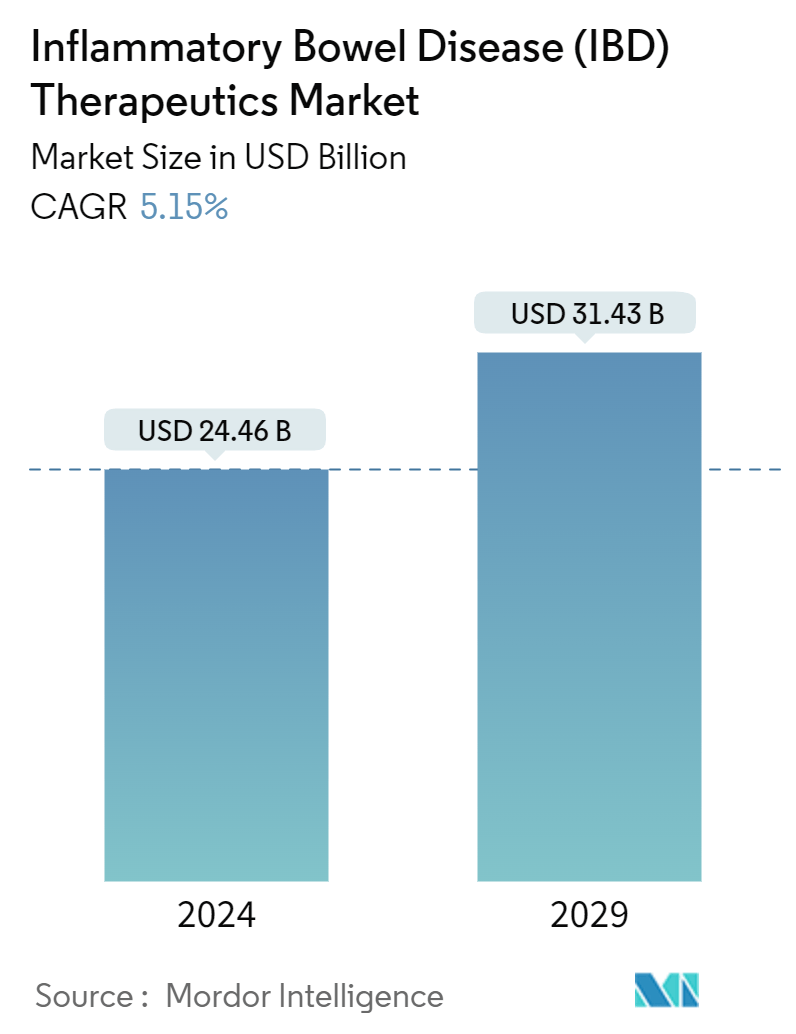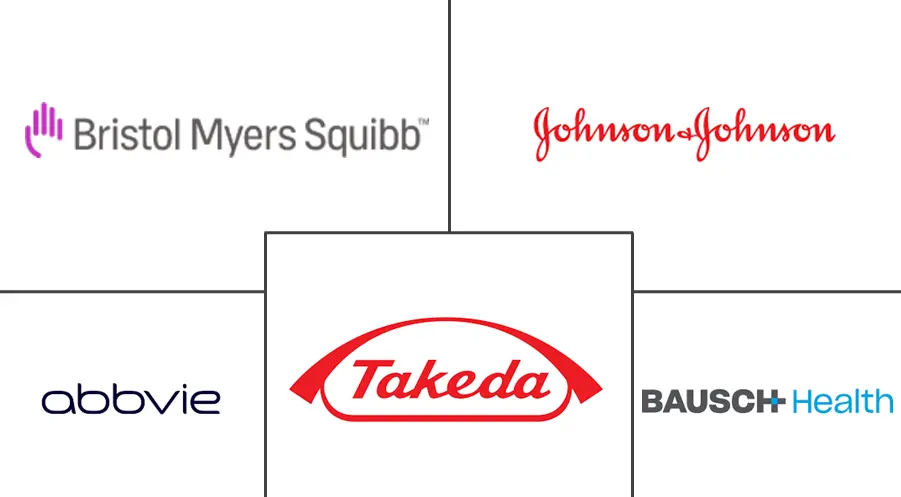Market Size of Inflammatory Bowel Disease (IBD) Therapeutics Industry

| Study Period | 2019 - 2029 |
| Market Size (2024) | USD 24.46 Billion |
| Market Size (2029) | USD 31.43 Billion |
| CAGR (2024 - 2029) | 5.15 % |
| Fastest Growing Market | Asia-Pacific |
| Largest Market | North America |
Major Players
*Disclaimer: Major Players sorted in no particular order |
Inflammatory Bowel Disease (IBD) Therapeutics Market Analysis
The Inflammatory Bowel Disease Therapeutics Market size is estimated at USD 24.46 billion in 2024, and is expected to reach USD 31.43 billion by 2029, growing at a CAGR of 5.15% during the forecast period (2024-2029).
With the rise of COVID-19, there was a rise in other complications associated with IBD, such as Crohn’s disease (CD) and ulcerative colitis, that arise along with the infection. For instance, according to a report by the Surveillance Epidemiology of Coronavirus Under Research Exclusion (SECURE-IBD) database in January 2022, adverse COVID-19 outcomes were associated with age and other co-morbidities among patients with IBD. The novel severe acute respiratory syndrome-related coronavirus, upon entering the gastrointestinal tract, initiates activation of innate and adaptive immune responses. The onset of inflammatory reactions can supposedly induce intestinal damage in IBD patients. Thus, there was an increased demand for IBD therapeutics to manage further complications that could develop due to COVID-19. However, as the pandemic has subsided currently, the studied market is expected to have stable growth during the forecast period of the study.
The increasing occurrence of Crohn’s disease and ulcerative colitis is the major driver, which is predicted to boost the growth of the market. For instance, according to the data updated by Crohn’s & Colitis United Kingdom in 2022, it is estimated that 1 in every 123 people in the United Kingdom have either Crohn’s disease or ulcerative colitis, which amounts to a total of nearly half a million people in the United Kingdom living with IBD. The source also stated that research conducted in the United Kingdom also suggested that there is a significant chance of comorbidity between IBD and other inflammatory diseases, which means that people who have already received a diagnosis of IBD are more likely to be diagnosed with other inflammatory diseases in the future. Thus, the high burden of IBD is expected to boost the usage of its therapeutics during the forecast period.
An increase in the approval of biologics and the presence of robust pipeline products are expected to propel the growth of the market. For instance, according to an article published by the World Journal of Clinical Cases in April 2023, biologic agents have been widely used in the management of inflammatory bowel disease (IBD) for many years, and currently, there has been increasing interest and experience using dual biologic therapy (DBT) in IBD, primarily in difficult to treat and refractory cases with high disease burden. The increasing use of biologic therapies in IBD patients provides lucrative opportunities for market growth attributed to the vast costs of biologics.
However, a lack of awareness among people about IBD is expected to limit the growth of the market.
Inflammatory Bowel Disease (IBD) Therapeutics Industry Segmentation
As per the scope of the report, inflammatory bowel disease (IBD) is characterized by chronic inflammation of the gastrointestinal (GI) tract. The two classifications of IBD are Crohn’s disease and ulcerative colitis. Prolonged inflammation can cause damage to the GI tract. The Inflammatory Bowel Disease (IBD) therapeutics market is segmented by disease type (Crohn’s disease and ulcerative colitis), drug class (TNF inhibitors, JAK inhibitors, aminosalicylates, corticosteroids, and other drug classes), route of administration (oral and parenteral), end user (hospital pharmacies, online pharmacies, and retail pharmacies), and geography (North America, Europe, Asia-Pacific, Middle East and Africa, and South America). The market report also covers the estimated market sizes and trends of 17 countries across major regions globally.
The report offers values in (in USD) for the above segments.
| By Disease | |
| Crohn's disease | |
| Ulcerative colitis |
| By Drug Class | |
| TNF inhibitors | |
| JAK inhibitors | |
| Aminosalicylates | |
| Corticosteroids | |
| Other Drug Classes |
| By Route of administration | |
| Oral | |
| Parenteral |
| By End User | |
| Hospital pharmacies | |
| Online pharmacies | |
| Retail pharmacies |
| Geography | ||||||||
| ||||||||
| ||||||||
| ||||||||
| ||||||||
|
Inflammatory Bowel Disease (IBD) Therapeutics Market Size Summary
The Inflammatory Bowel Disease (IBD) therapeutics market is poised for steady growth, driven by the increasing prevalence of conditions such as Crohn’s disease and ulcerative colitis. The market is experiencing a surge in demand for therapeutics due to the complications arising from COVID-19, which have highlighted the need for effective management of IBD. The market is characterized by the rising approval of biologics and the development of robust pipeline products, which are expected to propel growth. The use of Janus Kinase (JAK) inhibitors and combination therapies is also gaining traction, offering new avenues for treatment and contributing to market expansion. Despite these advancements, a lack of awareness about IBD remains a challenge that could potentially limit market growth.
North America is anticipated to be a significant growth region, supported by the high prevalence of IBD and the presence of key market players. The region benefits from extensive research and development activities by pharmaceutical and biopharmaceutical companies, which are focused on developing innovative therapeutics for IBD. The market is competitive and fragmented, with major players like Bristol-Myers Squibb, AbbVie, and Johnson & Johnson leading the charge. Recent approvals of new treatments by these companies underscore the dynamic nature of the market. As the burden of IBD continues to rise, particularly in North America, the demand for effective therapeutics is expected to increase, driving market growth during the forecast period.
Inflammatory Bowel Disease (IBD) Therapeutics Market Size - Table of Contents
-
1. MARKET DYNAMICS
-
1.1 Market Overview
-
1.2 Market Drivers
-
1.2.1 Increasing Research on IBD Treatment
-
1.2.2 Increasing Occurrence of Crohn's Disease and Ulcerative Colitis
-
-
1.3 Market Restraints
-
1.3.1 Strict Drug Regulatory Policies
-
1.3.2 Lack of awareness among people
-
-
1.4 Porter's Five Forces Analysis
-
1.4.1 Bargaining Power of Suppliers
-
1.4.2 Bargaining Power of Buyers/Consumers
-
1.4.3 Threat of New Entrants
-
1.4.4 Threat of Substitute Products
-
1.4.5 Intensity of Competitive Rivalry
-
-
-
2. MARKET SEGMENTATION (Market Size by Value – USD)
-
2.1 By Disease
-
2.1.1 Crohn's disease
-
2.1.2 Ulcerative colitis
-
-
2.2 By Drug Class
-
2.2.1 TNF inhibitors
-
2.2.2 JAK inhibitors
-
2.2.3 Aminosalicylates
-
2.2.4 Corticosteroids
-
2.2.5 Other Drug Classes
-
-
2.3 By Route of administration
-
2.3.1 Oral
-
2.3.2 Parenteral
-
-
2.4 By End User
-
2.4.1 Hospital pharmacies
-
2.4.2 Online pharmacies
-
2.4.3 Retail pharmacies
-
-
2.5 Geography
-
2.5.1 North America
-
2.5.1.1 United States
-
2.5.1.2 Canada
-
2.5.1.3 Mexico
-
-
2.5.2 Europe
-
2.5.2.1 Germany
-
2.5.2.2 United Kingdom
-
2.5.2.3 France
-
2.5.2.4 Italy
-
2.5.2.5 Spain
-
2.5.2.6 Rest of Europe
-
-
2.5.3 Asia-Pacific
-
2.5.3.1 China
-
2.5.3.2 Japan
-
2.5.3.3 India
-
2.5.3.4 Australia
-
2.5.3.5 South Korea
-
2.5.3.6 Rest of Asia-Pacific
-
-
2.5.4 Middle East and Africa
-
2.5.4.1 GCC
-
2.5.4.2 South Africa
-
2.5.4.3 Rest of Middle East and Africa
-
-
2.5.5 South America
-
2.5.5.1 Brazil
-
2.5.5.2 Argentina
-
2.5.5.3 Rest of South America
-
-
-
Inflammatory Bowel Disease (IBD) Therapeutics Market Size FAQs
How big is the Inflammatory Bowel Disease Therapeutics Market?
The Inflammatory Bowel Disease Therapeutics Market size is expected to reach USD 24.46 billion in 2024 and grow at a CAGR of 5.15% to reach USD 31.43 billion by 2029.
What is the current Inflammatory Bowel Disease Therapeutics Market size?
In 2024, the Inflammatory Bowel Disease Therapeutics Market size is expected to reach USD 24.46 billion.

